A bone folder is a versatile and indispensable tool used in various creative and craft disciplines, particularly in bookbinding, paper crafting, and printmaking.
Despite its name, modern bone folders are typically made from plastic or wood, mimicking the traditional bone material.
This tool features a smooth, flat, and often slightly pointed shape, designed to assist in folding, creasing, and shaping paper, fabric, or other materials with precision and ease.
Crafters and artisans use bone folders to create crisp, professional-looking folds, smooth out wrinkles, and score paper for clean, precise cuts.
Its multifunctional nature makes it a staple in the toolkit of anyone involved in fine craftsmanship and artistic endeavors.
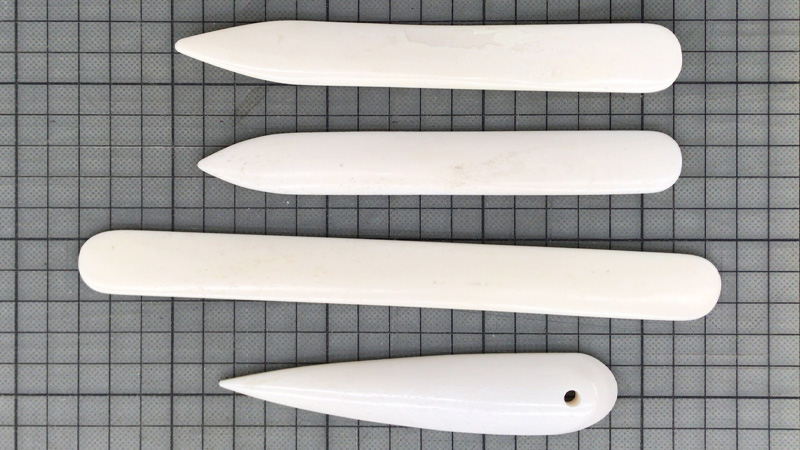
What Is a Bone Folder?
A bone folder is a hand tool traditionally made from bone, though modern versions are often crafted from plastic, wood, or other materials.
It is a small, flat, and smooth implement with a pointed end, frequently used in various arts and crafts disciplines.
Bone folders are invaluable in bookbinding, paper crafting, and printmaking, among other creative pursuits.
Their primary purpose is to assist in folding, creasing, and shaping materials like paper, cardboard, or fabric with precision.
Crafters use bone folders to create sharp folds, smooth out wrinkles, and score paper to facilitate clean and precise cuts.
They are versatile tools that help artisans achieve professional and polished results in their projects.
What Is a Bone Folder Used For?
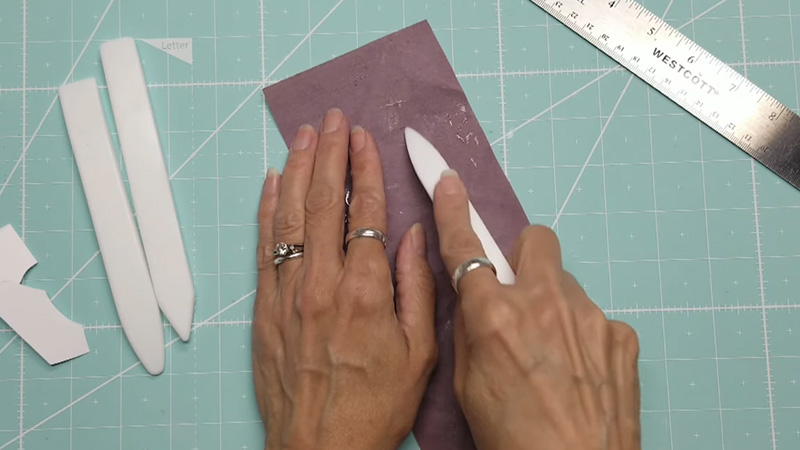
A bone folder is a versatile hand tool used in various craft and creative disciplines for a wide range of purposes.
While it was traditionally made from bone (hence the name), modern bone folders are often made from plastic, wood, or other materials.
Here are some common uses for a bone folder:
Folding Paper
Bone folders excel in paper folding, a fundamental skill in origami, card making, and paper crafting. They ensure crisp, clean folds in various paper types, from delicate tissue paper to heavy cardstock, enhancing the overall aesthetics of the project.
Creasing
In bookbinding, box making, and packaging design, bone folders are indispensable for creating precise creases.
They ensure that materials like paperboard, cardboard, and bookbinding cloth fold neatly and uniformly, contributing to the structural integrity of the final product.
Scoring
When planning to fold paper or cardstock, scoring is a critical step. Bone folders score the material by gently pressing along a straight line, making it easier to fold without cracking or tearing. This technique is commonly used in greeting card production and papercrafts.
Smoothing
Bone folders are skilled at eliminating wrinkles, air bubbles, or unevenness in various materials, such as laminated sheets, adhesive vinyl, or fabric.
This smoothing action is especially crucial in scrapbooking and other projects where a flawless appearance is desired.
Detail Work
The pointed or narrower end of a bone folder is ideal for intricate tasks. Crafters use it to create fine details, such as tight folds in origami or precise creases in small paper embellishments for handmade cards.
Bookbinding
Bookbinders rely heavily on bone folders to flatten book pages, align signatures, and ensure a professional finish to bound books. They are crucial for achieving a polished and durable bookbinding result.
Printmaking
In printmaking, bone folders aid in the transfer of ink from a printing plate to paper. They help ensure an even distribution of ink, consistent pressure, and proper adhesion to the printing surface, resulting in high-quality prints.
Box Making
When crafting custom boxes and containers, bone folders are used to crease and fold heavyweight materials like cardboard, chipboard, or corrugated board. This precise folding is essential for constructing sturdy and aesthetically pleasing boxes.
Leatherworking
Leather crafters employ bone folders to smooth and shape the edges of leather pieces. This process gives the leather a refined, professional appearance, particularly in projects like wallets, belts, and leather bags.
Crafting and DIY Projects
Bone folders find their way into various DIY projects, such as handmade envelopes, scrapbook layouts, and paper crafting projects. Their versatility and precision make them valuable assets for creative endeavors.
Paper Conservation
Conservators and restorers use bone folders in the delicate process of paper conservation. These tools help flatten and repair aged or damaged paper documents, books, and artworks, preserving them for future generations.
Clay and Polymer Clay Work
Some artists and crafters use bone folders to manipulate and shape clay or polymer clay in sculpting and modeling projects. They can create smooth surfaces and refine details in clay sculptures.
What Is a Bone Folder Made Of
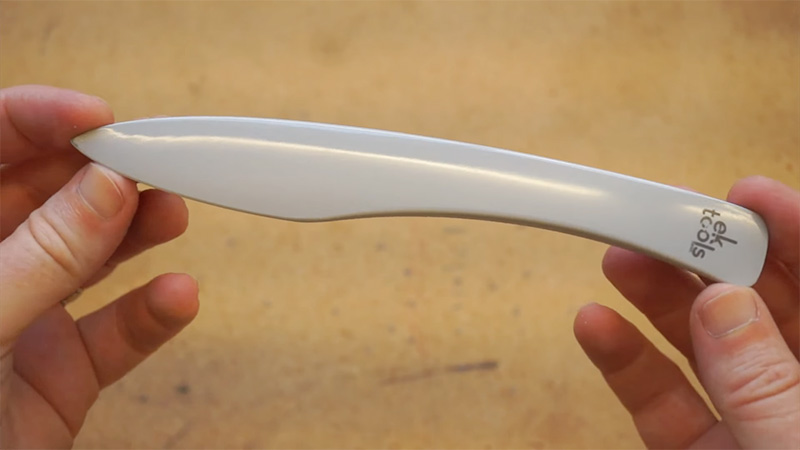
A bone folder is traditionally made from bone, typically the leg bone of a cow or deer. The use of bone for crafting tools dates back centuries and bone folders were historically used in bookbinding, paper crafting, and other crafts due to their smooth, hard, and slightly polished surface.
However, in modern times, bone folders are also made from various alternative materials, including:
Bone
Historically, bone folders were crafted from animal bones, typically the leg bones of cows or deer. These bones were chosen for their density, smoothness, and suitability for crafting purposes.
Bone folders made from actual bone have a natural and slightly polished surface. They are durable and have a unique tactile quality.
Plastic
Plastic bone folders are widely available and are often used as a cost-effective alternative to traditional bone folders.
They closely mimic the traditional design and come in various shapes and sizes. Plastic bone folders are lightweight and easy to handle.
Wood
Wooden bone folders are made from hardwoods like maple or beech. They are appreciated by environmentally conscious crafters because wood is a renewable and sustainable resource.
Wooden bone folders provide a tactile and warm feel, making them a favorite among some crafters.
Bamboo
Bamboo bone folders have gained popularity due to bamboo’s renewable nature and low environmental impact. They are lightweight, smooth, and offer an eco-friendly option for crafting projects.
Teflon
Teflon or PTFE bone folders have a non-stick surface, making them ideal for tasks involving adhesives, tapes, and other sticky materials. Residue from adhesives does not easily adhere to Teflon, simplifying cleanup.
Metal
Metal bone folders, often made from materials like aluminum or stainless steel, are used for specific applications such as embossing or metalworking. They are sturdy and withstand heavy use in specialized crafting tasks.
Acrylic
Acrylic bone folders offer a clear, smooth, and rigid surface for crafting tasks. The transparency of acrylic bone folders can be advantageous when precision is essential.
How to Make a Bone Folder?
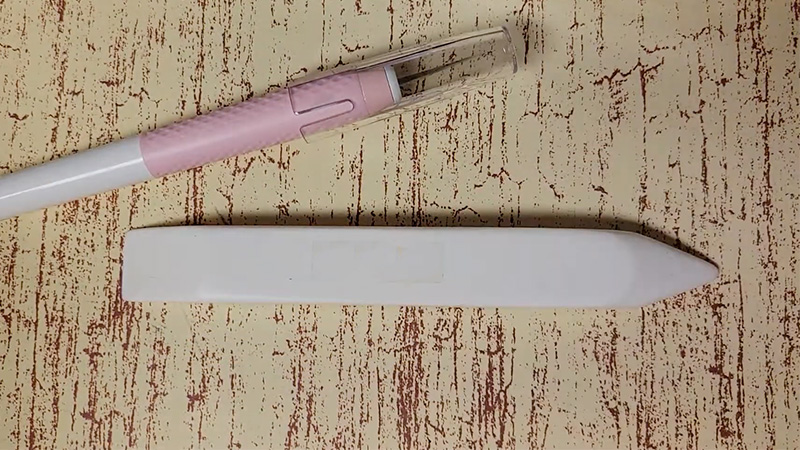
Creating a bone folder is a crafty endeavor that allows you to customize the tool according to your preferences.
Here’s a step-by-step guide on how to make a bone folder:
Materials you’ll need:
- Bone blank or a suitable alternative material like plastic, wood, or horn.
- Sandpaper
- Ruler
- Pencil
- Saw
- Files
- Fine-grit emery cloth or sanding sponge
- Polishing compound or wax
Steps:
Design your bone folder
Decide on the shape and size you want for your bone folder. Standard bone folders are usually flat and have a pointed end, but you can experiment with different designs.
Cut the blank
If you’re using a bone blank, measure and mark the desired length on it. Use a saw to carefully cut the blank to size. If you’re using an alternative material, cut it to your chosen shape and size.
Shape the folder
Using a file, start shaping the bone folder. Focus on rounding off the edges and creating a smooth, flat surface. Keep checking the shape against your design.
Refine with sandpaper
Gradually move from coarse to fine-grained sandpaper to smooth the surface further. Start with a coarse grit (e.g., 100) and progress to finer grits (e.g., 400, 800, and 1200) for a polished finish.
Pointed end
If your design includes a pointed end, use the sandpaper and files to shape it into a fine point. Be patient and make sure it’s symmetrical.
Smooth the entire surface
Use a fine-grit emery cloth or sanding sponge to create a uniform and smooth texture on the entire bone folder.
Polish
Apply a polishing compound or wax to the bone folder’s surface. This adds shine and protects the material.
Final touch
Clean the bone folder thoroughly to remove any residue from the polishing compound or wax. You can use a soft cloth or paper towel.
Test
Ensure your bone folder is comfortable to hold and works effectively by testing it on paper or other materials.
Customize (optional): You can personalize your bone folder by adding decorative elements or your name using engraving tools or paint.
Bone Folder Alternatives
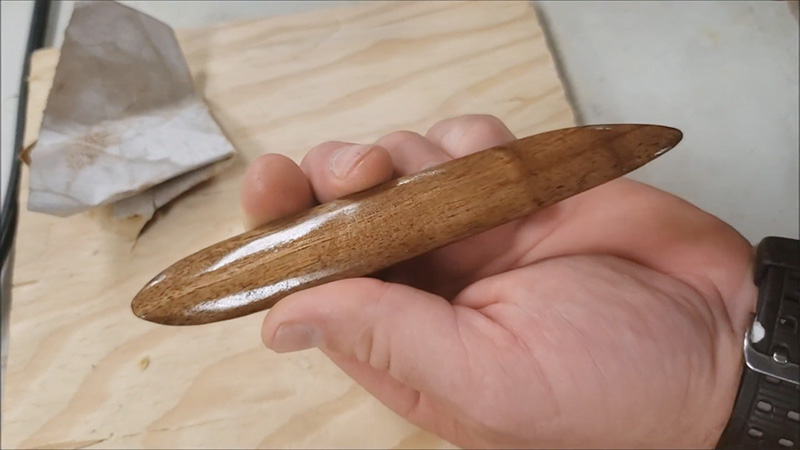
While bone folders are versatile tools widely used in various crafts, there are several alternative options for those who prefer not to use animal bone-based tools or wish to explore different materials.
Here are some bone folder alternatives:
Plastic Bone Folders
These are commonly available and mimic the shape and functionality of traditional bone folders. They are lightweight, durable, and affordable, making them an excellent choice for beginners and environmentally conscious crafters.
Wooden Creasers
Wooden tools with a similar shape to bone folders are available and work well for many of the same tasks.
They are often made from hardwoods like maple or beech and provide a natural and eco-friendly alternative.
Teflon Folders
Teflon or PTFE (polytetrafluoroethylene) bone folders have a non-stick surface, making them ideal for working with adhesive materials like tape, glue, or adhesives used in paper crafts and bookbinding.
Metal Rulers
For scoring paper or cardstock, a metal ruler with a straight edge can be used in combination with a dull pointed tool, such as a knitting needle or a rounded-end screwdriver. This is a budget-friendly alternative for simple scoring.
Burnishing Tools
Some crafters use burnishing tools made from materials like acrylic, acrylic blends, or other synthetic materials to smooth paper or apply pressure during adhesive bonding. These tools come in various shapes and sizes for different tasks.
Bamboo Sticks
Bamboo sticks or dowels can serve as alternatives for bone folders when you need a rounded, smooth tool to apply pressure or smooth paper or fabric. They are eco-friendly and can be found in various thicknesses.
Dull Plastic Knives or Spatulas
In a pinch, a dull plastic knife or spatula from the kitchen can work as a makeshift bone folder for certain tasks, such as smoothing adhesive or folding paper.
Finger Press
Your fingers can be used to fold or crease paper, especially if you need to create a soft, subtle crease. Just be sure to apply even pressure for a neat result.
Crafting Brayers
A brayer is a roller tool often used in printmaking, but it can also be helpful for smoothing paper and applying even pressure in various craft projects.
DIY Alternatives
Crafters often get creative and fashion their own tools from household items like popsicle sticks, old credit cards, or plastic lids. These DIY alternatives can be customized to suit specific tasks.
FAQS
Are all bone folder tools made from the actual bone?
No, while traditional bone folders were made from bone, modern versions are often crafted from plastic, wood, or other materials.
What is a bamboo bone folder?
A bamboo bone folder is a specific type of bone folder tool made from bamboo.
What should I consider when looking for the best bone folder?
When searching for the best bone folder, consider factors like the material (plastic, wood, bamboo), the shape (flat or pointed), your crafting needs, and your personal preferences in terms of comfort and durability.
Can bone folders be used for embossing or debossing in crafting?
Yes, bone folders are often used in embossing and debossing techniques to create raised or recessed designs in paper or other materials.
Last Words
A bone folder is a versatile and essential tool in the world of crafting and bookbinding.
While it was traditionally crafted from animal bones, modern versions are now available in various materials, including plastic, wood, bamboo, and more.
Regardless of the material, bone folders serve the common purpose of folding, creasing, scoring, and smoothing various materials, such as paper, fabric, and leather, with precision and finesse.
Crafters, artisans, and bookbinders rely on these tools to achieve crisp, professional finishes in their projects.
Whether for origami, cardmaking, or bookbinding, the bone folder’s versatility and utility make it an indispensable companion for any creative endeavor.
Leave a Reply